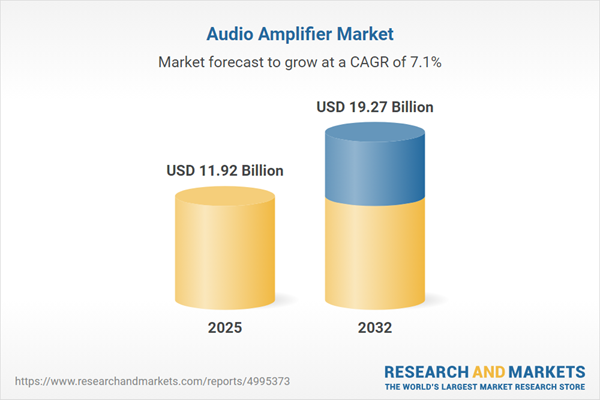Speak directly to the analyst to clarify any post sales queries you may have.
The Audio Amplifier Market is evolving rapidly on the strength of technological innovation, dynamic end-user demand, and global supply chain shifts. Senior decision-makers managing technology portfolios must navigate a competitive ecosystem shaped by efficiency demands, modular platform adoption, and new tariff impacts.
Market Snapshot: Audio Amplifier Market Growth and Trends
The audio amplifier market grew from USD 11.13 billion in 2024 to USD 11.92 billion in 2025. It is projected to continue expanding at a CAGR of 7.10%, with revenues expected to reach USD 19.27 billion by 2032. Market growth is driven by rising consumer standards for sound performance, robust industrial and automotive adoption, and product advancements targeting energy efficiency and integrated connectivity. Senior executives will benefit from understanding how diverse demand scenarios intersect with ongoing supply chain adaptations and regional growth engines.
Scope & Segmentation
- Technology Classes: Includes Class A, Class AB, Class D, Class G, and Class H amplifier types, each influencing efficiency, thermal management, and sound fidelity profiles.
- Product Types: Segment covers integrated amplifiers, standalone power amplifiers, and preamplifiers, each suited to distinct application requirements in modularity, compactness, and gain management.
- End Users: Automotive, commercial, consumer electronics, and industrial segments form the primary domains, reflecting diverse needs for immersive audio, reliability, and integration.
- Distribution Channels: Direct sales, retail partners, system integrators (offline), and online channels highlight routes to market. Omnichannel strategies are becoming critical for supply chain agility and customer reach.
- Power Output: Solutions range from low to high power to support battery-powered devices, home theater, and large-scale event needs.
- Geographical Regions: Americas (North America, Latin America), Europe, Middle East & Africa (with detailed countries), and Asia-Pacific (including China, India, Japan, South Korea, and others).
- Key Companies Analyzed: Allen & Heath Ltd., AMETEK.Inc., Analog Devices, Inc., Anthem, Bose Corporation, Bryston Ltd., Cirrus Logic, Inc., Diodes Incorporated, DIOO Microcircuits Co., Ltd., Harman International Industries (Samsung Electronics), Infineon Technologies AG, Integrated Silicon Solution Inc., Kenwood Corporation, McIntosh Laboratory, Monolithic Power Systems, NAD Electronics International (Lenbrook Industries).
Key Takeaways for Decision-Makers
- Innovation cycles in amplifier design are accelerating, with digital integration and hybrid topologies setting new market standards.
- Automotive and commercial installations drive volume, prompted by vehicle infotainment and smart building trends.
- Regional shifts and local sourcing are increasing as supply chains adapt to regulatory changes and tariff policies.
- Strategic collaborations between semiconductor firms and amplifier manufacturers accelerate integration and differentiate product portfolios.
- Manufacturers are investing in solutions that balance power efficiency, heat dissipation, and connectivity, enhancing adaptability across end-user applications.
- Distribution strategy diversification, including a strong online presence and seamless omnichannel experiences, is vital for sustaining market access and customer engagement.
Tariff Impact: Navigating Cost Pressures and Resilient Supply Chains
United States tariff policies introduced in 2025 have increased input costs for key components and complete amplifier modules. Industry leaders are responding by optimizing sourcing through domestic partnerships and nearshore assembly, reducing dependency on affected imports. Design-for-cost initiatives, integrated solutions, and close collaboration with logistics providers have emerged as critical levers to maintain margin stability and fulfill contractual obligations. These strategic responses highlight the need for adaptability and supply chain resilience within the amplifier ecosystem.
Methodology & Data Sources
This study integrates qualitative insights from industry interviews with amplifier designers, suppliers, integrators, and end-users, along with quantitative surveys targeting channel preferences and product functionality requirements. Secondary research complements these findings by examining technical standards, regulatory documentation, and patent trends. Data was validated through triangulation and expert workshops to ensure robust and actionable analytics.
Why This Report Matters
- Enables senior leaders to benchmark their strategy against evolving amplifier technologies and supply chain realities.
- Supports proactive planning in response to global and regional regulatory developments, including trade impacts and compliance requirements.
- Delivers actionable insights across key technology adoption, distribution models, and regional market entry opportunities.
Conclusion
The audio amplifier sector is advancing through continual technical dynamism and strategic partnerships. Forward-looking organizations will benefit by aligning their innovation roadmaps and sourcing strategies to capture shifting market opportunities and mitigate emerging risks.
Additional Product Information:
- Purchase of this report includes 1 year online access with quarterly updates.
- This report can be updated on request. Please contact our Customer Experience team using the Ask a Question widget on our website.
Table of Contents
3. Executive Summary
4. Market Overview
7. Cumulative Impact of Artificial Intelligence 2025
Companies Mentioned
The companies profiled in this Audio Amplifier market report include:- Allen & Heath Ltd.
- AMETEK.Inc.
- Analog Devices, Inc.
- Anthem
- Bose Corporation
- Bryston Ltd.
- Cirrus Logic, Inc.
- Diodes Incorporated
- DIOO Microcircuits Co., Ltd.
- Harman International Industries, Incorporated by Samsung Electronics Co., Ltd.
- Infineon Technologies AG
- Integrated Silicon Solution Inc.
- Kenwood Corporation
- McIntosh Laboratory, Inc.
- Monolithic Power Systems, Inc.
- NAD Electronics International by Lenbrook Industries Limited
Table Information
| Report Attribute | Details |
|---|---|
| No. of Pages | 180 |
| Published | November 2025 |
| Forecast Period | 2025 - 2032 |
| Estimated Market Value ( USD | $ 11.92 Billion |
| Forecasted Market Value ( USD | $ 19.27 Billion |
| Compound Annual Growth Rate | 7.1% |
| Regions Covered | Global |
| No. of Companies Mentioned | 17 |









